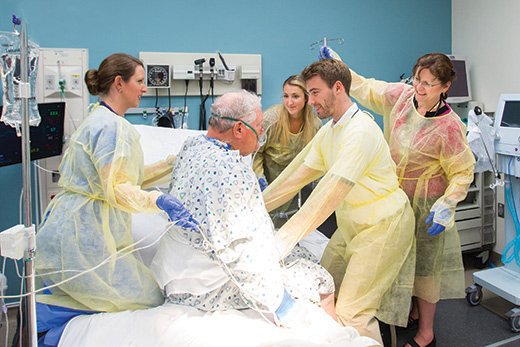There’s a simple reason why Alex Johnson 17DPT tried to avoid intensive care units (ICUs) during her first clinical rotations: “I was petrified,” she says. Ventilators, lines, monitors, and questions about patients’ medical stability made her hesitate. “When I walked into an ICU, I was automatically intimidated,” she says. “Patients were so ill. They seemed so fragile.”
Johnson knew she had a decision to make. She could continue to avoid critically ill patients with complex conditions—or she could learn everything she could to overcome her fear. Because she wanted to be able to work in a hospital, she decided on the latter. Because she was a student in Emory’s Division of Physical Therapy, there was a clear way to get the information and experience she was looking for: Emory’s Advanced Acute Care elective. It’s the first and
For course co-instructor Jenny Sharp 11DPT, the idea began with a chance meeting in an ICU at Emory University Hospital Midtown. Alex Truong, MD, MPH, had been conducting research on the benefits of early mobilization, a set of coordinated protocols to help even the sickest patients begin to sit, stand, and walk again as quickly and safely as possible. He wanted Sharp’s support in creating a protocol for treating patients in intensive care who could benefit from physical therapy.
Truong knew that physical therapists would be crucial for creating and implementing a protocol that worked. “Nurses and doctors underestimate what our patients can do physically,” says Truong, an assistant professor of medicine at Emory. “Physical therapists are best at challenging patients to optimize their functioning.”
For other health care professionals, encouraging critically ill patients to be physically active can seem counterintuitive. “All everybody sees at first is
Yet research shows that the adverse reaction rate for early mobility efforts is between 1% and 3%. The most common reactions are drops in oxygen saturation and blood pressure.
In addition, research by Truong and others has shown that bed rest for patients may hurt more than help. “In the old model of acute care treatment, patients just languished in bed and became very weak,” says Sharp. Recent studies show that a stint of hospital bed rest may lead to weakened states for subsequent years—including decreases in nerve conduction, debilitating muscle weakness, and resulting challenges in going back to work or family life. Research has also shown that early mobilization efforts can result in decreased complications, shorter lengths of hospital stays, and lower hospital readmission rates.
Soon, Sharp found herself serving as an early mobility coordinator at Emory University Hospital Midtown, training other staff members on the benefits of getting critically ill patients moving. At the same time, she was doing what she could to gain confidence and competency with her own acute care patients. “I was educating myself on the different equipment and medical diagnoses that you typically see in critical care,” she said.
Occasionally, Sharp would think back to her coursework at Emory. “The electives I had taken were fabulous, but none of them prepared me for what I was doing in acute care,” says Sharp. In 2012, she started drafting an email to Professor Marie Johanson,

